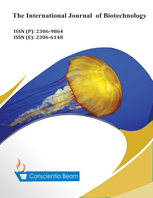Extraction and Characterization of Chitin and Chitosan Biopolymer as Wound Healing Material Using Shrimp Shells
DOI:
https://doi.org/10.18488/journal.57.2021.102.69.75Abstract
Wound refers to any damage or disruption to the normal anatomical structure. In our everyday pathology, wounds remains one of the demanding clinical problems with it related complications which increases mortality and morbidity rate yearly. In this study, chitin and chitosan were extracted from shrimp shells waste by chemical method, treated with an acid and an alkali which gave a yield of 12 % and 66.57 % respectively. The chemical extraction method included demineralization where the sample was treated with hydrochloric acid (HCL) under a specific temperature. The sample was then treated with sodium hydroxide (NaOH) to remove all the protein in the material at a specific temperature. To obtain the chitosan, the chitin was treated with 50% NaOH at a temperature of 1000C. E.coli proved to be more susceptible in antimicrobial studies with a value of 11.67± 0.47. The FTIR spectra gave a characteristic bands of –NH at 3430.09 cm-1, OH at 3256.32 cm-1.At 2960.75 cm-1, NH was attached to a single bond. The characteristics of produced chitosan were in accordance with the commercial standard that showed a higher percentile yield posing many properties of commercial value and greater scope of industrial applications. This study revealed that shrimp shell waste could be effectively utilized for the extraction of chitin, chitosan, and chitooligomer for industrial applications. The zone of inhibition study of E.coli shows that chitosan and COS may have a high antimicrobial property hence it usefulness in the wound healing management.

